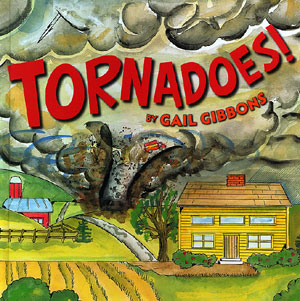Tornadoes!
Written and illustrated by Gail Gibbons
Published by Holiday House in 2009
32 pages
Genre: science, non-fiction, picture book

As I was searching for an informational book, I came across this one. Tornadoes are a scary subject, but the art looked so cute that it gave it friendly spin. One of my favorite things to teach about is weather, so I was interested right off the bat. This informational book explains what tornadoes are, how they form, and what to do if you are faced with one. I like that it includes how to stay safe in a tornado.
The illustrations are colorful, detailed, and fun to look at. A child could learn a lot just by looking at the pictures. Gail Gibbons uses acrylic paint. The pictures give a lot of meaning to the book's topic and supports the written words. I
like how they depicted the damaged that each size of tornado could do
in more of a positive light, rather than them being dark and scary.
This book is great for first grade and up. This would be as a read aloud to introduce tornado drills in your school. You could relate tornadoes and art by letting the students make a collage. A science experiment showing how tornadoes form would be very interesting for students of all ages.














